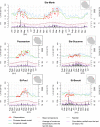Complementarity of empirical and process-based approaches to modelling mosquito population dynamics with Aedes albopictus as an example-Application to the development of an operational mapping tool of vector populations
- PMID: 31951601
- PMCID: PMC6968851
- DOI: 10.1371/journal.pone.0227407
Complementarity of empirical and process-based approaches to modelling mosquito population dynamics with Aedes albopictus as an example-Application to the development of an operational mapping tool of vector populations
Abstract
Mosquitoes are responsible for the transmission of major pathogens worldwide. Modelling their population dynamics and mapping their distribution can contribute effectively to disease surveillance and control systems. Two main approaches are classically used to understand and predict mosquito abundance in space and time, namely empirical (or statistical) and process-based models. In this work, we used both approaches to model the population dynamics in Reunion Island of the 'Tiger mosquito', Aedes albopictus, a vector of dengue and chikungunya viruses, using rainfall and temperature data. We aimed to i) evaluate and compare the two types of models, and ii) develop an operational tool that could be used by public health authorities and vector control services. Our results showed that Ae. albopictus dynamics in Reunion Island are driven by both rainfall and temperature with a non-linear relationship. The predictions of the two approaches were consistent with the observed abundances of Ae. albopictus aquatic stages. An operational tool with a user-friendly interface was developed, allowing the creation of maps of Ae. albopictus densities over the whole territory using meteorological data collected from a network of weather stations. It is now routinely used by the services in charge of vector control in Reunion Island.
Conflict of interest statement
The authors have declared that no competing interests exist.
Figures





References
-
- WHO. A global brief on vector-borne diseases. 2014.
-
- Adde A, Roux E, Mangeas M, Dessay N, Nacher M, Dusfour I, et al. Dynamical Mapping of Anopheles darlingi Densities in a Residual Malaria Transmission Area of French Guiana by Using Remote Sensing and Meteorological Data. PLoS One. 2016; 11(10):e0164685 10.1371/journal.pone.0164685 - DOI - PMC - PubMed
Publication types
MeSH terms
LinkOut - more resources
Full Text Sources

